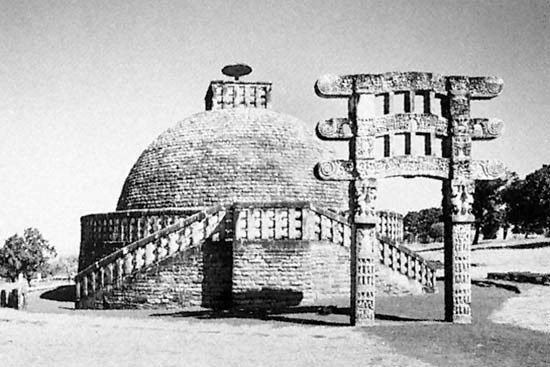stupa
Buddhism
 Buddhist commemorative monument usually housing sacred relics associated with the Buddha or other saintly persons. The hemispherical form of the stupa appears to have derived from pre-Buddhist burial mounds in India. As most characteristically seen at Sanchi (Sānchi) in the Great Stupa (2nd–1st century BC), the monument consists of a circular base supporting a massive solid dome (the anda, “egg,” or garbha, “womb”) from which projects an umbrella. The whole of the Great Stupa is encircled by a railing and four gateways, which are richly decorated with relief sculpture depicting Jataka (Jātaka) tales, events in the life of the Buddha, and popular mythological figures.
Buddhist commemorative monument usually housing sacred relics associated with the Buddha or other saintly persons. The hemispherical form of the stupa appears to have derived from pre-Buddhist burial mounds in India. As most characteristically seen at Sanchi (Sānchi) in the Great Stupa (2nd–1st century BC), the monument consists of a circular base supporting a massive solid dome (the anda, “egg,” or garbha, “womb”) from which projects an umbrella. The whole of the Great Stupa is encircled by a railing and four gateways, which are richly decorated with relief sculpture depicting Jataka (Jātaka) tales, events in the life of the Buddha, and popular mythological figures.The Indian conception of the stupa spread throughout the Buddhist world and evolved into such different-looking monuments as the bell-shaped dagaba (“heart of garbha”) of Ceylon (Sri Lanka), the terraced temple of Borobudur in Java, the variations in Tibet, and the multistoried pagodas of China, Korea, and Japan. The basic symbolism, in which the central relic is identified with the sacred person or concept commemorated and also with the building itself, is retained. Worship of a stupa consists in walking around the monument in the clockwise direction. Even when the stupa is sheltered by a building, it is always a freestanding monument.
Buddhist stupas were originally built to house the earthly remains of the historical Buddha and his associates and are almost invariably found at sites sacred to Buddhism. The concept of a relic was afterward extended to include sacred texts. Miniature stupas and pagodas (pagoda) are also used by Buddhists throughout Asia as votive offerings. Stupas were also built by adherents of Jainism to commemorate their saints.
- Stephen
- Stephen A Douglas
- Stephen Austin
- Stephen Bleecker Luce
- Stephen Breyer
- Stephen Báthory
- Stephen Colbert
- Stephen Cole Kleene
- Stephen Crane
- Stephen Day
- Stephen D Bechtel
- Stephen Decatur
- Stephen Decatur Button
- Stephen Dobyns
- Stephen Edelston Toulmin
- Stephen Fairbairn
- Stephen F. Austin State University
- Stephen Foster
- Stephen Gardiner
- Stephen Gary Wozniak
- Stephen Girard
- Stephen Groombridge
- Stephen Hales
- Stephen Harper
- Stephen Hawes